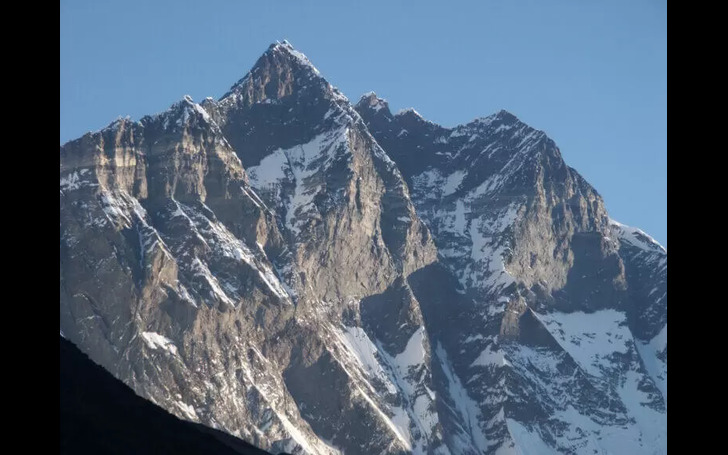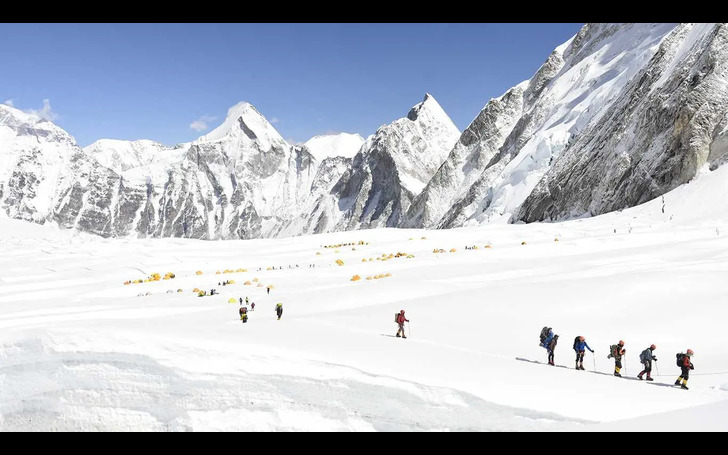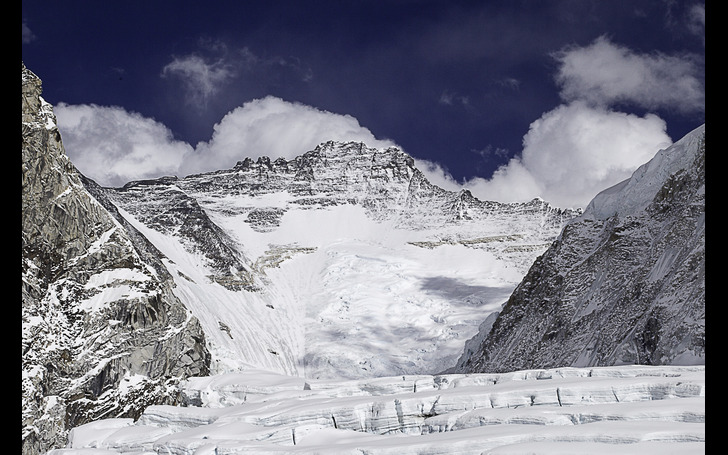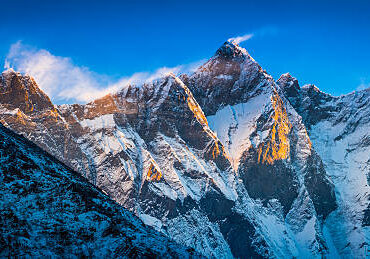- info@destinationholidaytrek.com
- +977-9768913779
- Gokarneshwor-6, Arubari, Kathmandu, Nepal
Lhotse Expedition (8,516m)
| Destination: | Nepal |
| Maximum Altitude: | 8,516 meters |
| Best Season: | Spring & Winter |
| Trip Grade: | Extreme Challenging |
| Group Size: | 1 – 15 people |
| Duration: | 50 Days |

The Mt. Lhotse Expedition is a 50-day journey to the summit of Mount Lhotse, which stands at an altitude of 8,516 meters (27,940 feet). The expedition follows the normal route, which largely overlaps with the Everest Expedition route due to Lhotse’s location within the Everest Massif. Although Lhotse requires more advanced rock climbing skills than Everest, it is considered physically less demanding. Despite this, it remains a formidable peak that must be approached with the highest level of caution and respect.
Lhotse is the fourth-highest mountain in the world and is situated 3 km south of Mount Everest. The mountain, which rises to 8,516 meters, is located on the border between Tibet and Nepal.
Lhotse is a part of the Everest Massif and is separated from Everest by the South Col. It consists of three peaks: Lhotse Main (8,516m), Lhotse East (8,414m), and Lhotse Shar (8,383m). Lhotse Shar, the lowest of the three, is often recognized as an independent 8,000-meter peak. Lhotse East, also known as Lhotse Middle, stands at 8,413 meters. Lhotse Main, the highest of the three, was first successfully climbed in 1956. However, Lhotse Middle remained unclimbed until 2001, making it one of the last significant Himalayan summits to be reached.
The Lhotse Couloir is the key passage leading to the summit. Located on the mountain’s west face, also known as the Lhotse Face, this steep ice gully poses the greatest challenge of the climb. In some sections, the incline reaches an angle of 80 degrees, making it extremely demanding for climbers. The route also features two notable rocky sections: the Yellow Band and the Geneva Spur. In addition to the technical difficulty of the terrain, climbers must remain cautious of unpredictable snowfall, which can significantly increase the risks associated with the ascent.
Lhotse Expedition Highlights

– Lhotse’s east-west crest is directly connected to Mount Everest.
– The mountain has three peaks: Lhotse Shar (8,383m), Lhotse East (8,413m), and Lhotse Main (8,516m).
– It is the fourth-highest mountain in the world.
– The route includes an extremely steep ice gully that rises 3.2 km.
– The expedition lasts around 50 days.
– The itinerary includes visits to Sherpa villages and Buddhist cultural centers.
– A 2.25 km stretch of steep glacial wall adds to the technical challenge.
– Climbers must endure extreme weather conditions.
– Lhotse is a perfect challenge for technically advanced mountaineers.
– The route offers an unforgettable experience of local culture.
– It is considered the best preparation for an Everest ascent.
– A more affordable alternative to climbing Mount Everest with similar conditions.
– Destination Holiday ensures excellent logistics and the highest safety standards.
What Makes Lhotse Expedition Famous?

Lhotse presents a formidable challenge, with some climbers considering its final 150-meter gully more technical and demanding than Everest’s ascent. It serves as a compelling alternative to Everest, offering a similar experience at a significantly lower permit cost.
As Lhotse and Everest are connected by the South Col, climbers can attempt Lhotse as an additional summit during an Everest expedition. The South Col, a sharp-edged pass on Lhotse’s west face, is regarded as the most difficult section of the climb due to extreme exposure and relentless winds that prevent snow accumulation.
At an altitude that never drops below 8,000 meters, the South Col is known as the “Death Zone,” where altitude sickness becomes a major risk. Many climbers fail to reach the summit due to the harsh conditions in this unforgiving environment.
Despite often being overshadowed by Everest, Lhotse is a remarkable peak, featuring a South Face that rises 3.2 km over just 2.25 km of horizontal distance, making it the steepest mountain face in the world. This section includes the Yellow Band, a sandstone layer where crampons lose effectiveness, adding to the difficulty.
Lhotse’s South Face remains one of the most dramatic and challenging in the world, notorious for numerous failed attempts, tragic fatalities, and only a few successful ascents. Another major obstacle is the Geneva Spur, a rocky ridge situated between Camp III and Camp IV, which must be navigated before reaching the South Col.
The Lhotse Expedition also requires crossing the Khumbu Icefall, one of the most dangerous sections due to its constantly shifting glacier formations. These treacherous features push even the most experienced climbers to their limits, making Lhotse a true test of skill and endurance.
Lhotse Expedition Overview

The Lhotse Expedition lasts 56 days, with Kathmandu as the starting and finishing point. Along the journey, climbers will visit Namche Bazaar, full of local culture, and the Tengboche Monastery, a key Buddhist center in the area. Afterward, the climb begins with high-altitude camps set along the way.
The trek to Mount Everest’s base takes four days and is one of the most famous routes, offering stunning views of the surrounding mountains and forests. The Lhotse route follows the same path as the Everest climb through the Khumbu Icefall. Above the Yellow Band, the paths split—climbers on Everest go left toward the South Col, while those heading to Lhotse turn right.
General Route Overview
The route begins at Everest Base Camp and follows the same trail through the Khumbu Icefall, passing through several camps. Camp I, at 5,900 meters, sits at the top of the Icefall, and Camp II is at 6,400 meters, offering fantastic views of Lhotse. After crossing glaciers and ice cliffs, Camp III is reached at 7,300 meters. The final Camp IV is set at 7,900 meters before the final steep climb to the summit.
Best Climbing Season for the Lhotse Expedition
The best time to climb Lhotse is during the spring months of April and May, when the conditions are most favorable. Alternatively, autumn (August to October) is also a great time to tackle this challenging climb, offering another period of good weather.
Included
- Airport/Hotel/airport transfers
- 5 nights’ accommodation at 3 star hotel in Kathmandu on twin sharing basis with breakfast and all taxes
- Fly from Kathmandu – Lukla– Kathmandu and all your luggage to Lhotse Base Camp and back to Lukla
- Lhotse Expedition Government Royalty
- All camping facilities and meals during the expedition including a tent (one member = one tent) at Base camp.
- Kitchen and Dining equipment, Eating utensils, Shower Tents, Toilet Tent, Store Tent, etc
- All porter wages costs from Kathmandu to lhotse base camp Base camp and back to Kathmandu
- All costs for support staff (guide, cook, kitchen helpers, and porters)
- Liaison officer, his fee, daily wages, equipment, clothing, accommodation, flight, meals, and insurance
- All our base camp staffs, porters, Climbing Sherpas, insurance, and their daily wages, and their equipment allowance.
- All breakfast, Lunch, Dinner, Tea, Coffee from during the trekking and Base Camp and till back to Kathmandu.
- Generator and Solar Panel at Base Camp
- National park fee
- Treking Guide and Base Camp Manager, his daily wages, insurance, equipment allowance, meals, accommodation etc
- Climbing Rope Fixing fee for Expedition operators Association of Nepal
- Satellite phone for Emergency use
- Necessary 0xyzen and mask regulator
- Breakfast, Lunch, Dinner, Tea, Coffee, Hot wate for shower at lhotse base camp
- Three time meal and tea, coffee during the trekking
- SPCC(Sagarmatha Pollution Control Committee) Garbage fee / Environmental Fee
- 4L poise 3 bottle for member and 2 bottle for guide and mask and regulator for summit
Excluded
- International flights and airport taxes.
- Visa fees.
- Bar bills and laundry.
- Travel insurance.
- Lunch and evening meals in Kathmandu.
- Tips for driver, guide, porter, BC staff and climbing Sherpas
- Successful Climbing Bonus for the Sherpa – (USD 1500 recommended)
- Personal Climbing Gear
Itinerary
The itinerary to Lhotse Expedition as follows:
01
Day 01 : Arrival in Kathmandu (1300 m) and transfer to the hotel.
Once you arrive at Tribhuwan Airport, the destination holiday trek will escort you to hotelat Thamel. You can relax there or explore the city. Our guide will arrive in the evening to discuss and prepare you for your trip to Mt. Lhotse Expedition.
02
Day 02 – 03 : Preparing expedition in Kathmandu
In these 2 days, we will make the final preparations and arrangements for your journey. You will meet your team, guides, and Sherpa and complete the government formalities like Expedition Permit, National Park permits, and related documentation. Our team will brief you about the climb to Mt. Lhotse via the normal route.
03
Day 04 : Fly to Lukla and trek to Phakding (2610m)
We start our Lhotse Expedition with a domestic flight to Lukla of about 35 mins. Established between a cliff and a hill with a short landing strip, Lukla Airport is known as one of the most dangerous airports in the world. We will then trek to Phakding (8km) which will take 3-4 hours. There are many cultural villages and you can view gorgeous Mount Khumbila and Mount KusumKangraru along the way. We will stay overnight at Phakding.
04
Day 05 : Trek to Namche Bazaar stay lodge (3440 m)
On the 5th day of our Expedition, we will trek up to Namche Bazaar along the DudhKoshi River. There are pine forests and several suspension bridges in the path we cross. We will also get to see the gateway of Sagarmatha National Park in Monjo. We will get our permits, there and climb to Namche Bazaar and stay there overnight. This trek will be 10 km and will take up to 5 hours.
05
Day 06 : Acclimatization day in Namche Bazar
Acclimatization day is a day to rest and to let our bodies adapt to the surrounding. Namche Bazar is the main trading center for the high Himalayas. There are a lot of cafes and restaurants there and the market is very lively and has a harmonious atmosphere. There is internet access and also has facilities of the hospital, post office, and a health post. There will be a short hike to explore the nearby villages as well.
06
Day 07 : Trek Namche – Deboche (3820m)
On day 7, we will head to Deboche. This trial will go along the glacial of the DudhKoshi River and extends to 11 km and will take 5/6 hrs. However, it gives a spectacular view of Mount Everest, Mt AmaDablam, Mt Nuptse, and numerous other mountains. The path goes along the forest of beautiful blooming Rhododendron to Sanasa. When we arriveSanasa we will reach a junction point which leads us to either Gokyo Valley or the Everest Base Camp. We take the second route and climb up the Tengboche Monastery and visit. This Monastery celebrates a 19 days colorful festival called Mani Rimdu in October or November. Witnessing this celebration will be an amazing experience. We will reach Deboche and spend the night there in a lodge.
07
Day 08 : Trek Deboche(3820m) to Dingboche (4410m)
Day 8 of our Lhotse Expedition will be a trek of 11 km which takes up to 6 hours. We descend to Imja River and then trek uphill to dense forest to the village of Pangboche. And walking past the steep Pheriche to the Lobuche River, we climb a steep hill and finally reach Dingboche also known as the Summer Valley in Khumbu region. We can see exotic views of Mt Makalu, Imja River, and open savannahs. Not to mention the fields of buckwheat, barley, and potatoes. We will rest the night in Dingboche.
08
Day 09 : Acclimatization day (4900m)
Day 9 is to rest and let your body adapt to the weather and surrounding. There are local villages that you can visit and get deeper insights into the culture and the lifestyles of the Sherpas. We will also go on a hike to Chukung village and even climb ChukungRi if you want. It has a phenomenal view of natural beauty and the Himalayas like Mt Cho Oyu, Mt Pumori, and the Lhotse wall.
09
Day 10 : Trek to Chukung (4730m)
On day 10 of the Lhotse Expedition, we will take a trek from Dingboche to Chukung which is located close to Island Peak. The route to Chukung has beautiful sceneries of the Himalayas. We will stay in a lodge for the night
010
Day 11 : Trek to Island Peak Base Camp (5200m)
Day 11 of the Lhotse Expedition gets rougher as the trail has boulders and glaciated rivers. We progress across through Lhotse glacier and arrive at the Base Camp for Island Peak, which has a magnificent view of the Island Peak. We will spend the night and rest at the Base Camp.
011
Day 12 : Climbing Training
Day 12 will be for giving you training for pre climbing by our team. Mountain climbing techniques, using climbing tools and gears like ascender, harness, etc properly. You will also receive training on how to use ropes during our climb and what safety measures to take. For practice sessions, you can climb up to High camp and then back to base Camp. We will rest the night in the Island peak base camp
012
Day 13 : Summit Island Peak (6,119m) and back to Chukung
Our Day 13 target of Lhotse Expedition is to climb the top of Island Peak. We will start the journey early in the morning. The route is moderate at first but has a steep hillside as you reach near the peak. The surrounding of the trail frequently changes and the views are amazing but the scenery from the peak is something you will experience as breathtaking. As you advance through the glaciers with the help of ropes, the temperature drops. The weather during the afternoon can be risky so we advance to reach the summit before noon. Once you reach the top, you will be able to see an astounding view of the gracious white snow-capped mountains like Mt Nuptse, Mt Lhotse, Makalu, AmaDablam, and Mt Baruntse.
013
Day 14 : Trek to Lobuche (4910m)
We will advance our journey by heading east and follow the dangerous region of this climb, the Khumbu Icefall via Kongma La. Though there are no settlements in this area, we can still find amazing and beautiful views of the Island Peak and AmphuLapcha Pass. We will proceed to the path along the river to reach our destination and stay overnight at Lobuche
014
Day 15 : Trek from Lobuche to Gorekshep (5170 m)
We pass through Khumbu Glacier where we can find memorials of many climbers ourselves. Amongst them are the memorials of 6 Sherpas who had died in an avalanche. Across the Khumbu Glacier, we will reach the ChangriNup glacier and then to Gorekshep. This trail will be 11 km and will take about 5-6 hours.
015
Day 16 : Trek to Lhotse Base Camp / Everest Base camp (5,364m)
We will start our day early on day 16 for trekking to Everest Base camp. Our journey today will take about 3/4 hours. The path gets harder and challenging as we ascend the altitude. But the snow-covered surroundings and view of the majestic mountains make it worthwhile. We walk through the rocky dunes to finally reach The Base Camp where we meet up with the rest of the team.
016
Day 17-20 : Lhotse Base Camp
During these days, our first target is well Acclimatization at Lhotse Base Camp/ Everest base camp and you can see the views of snow surrounding you everywhere as well as mount Pumori, Nuptse, and Lola. Lhotse Base Camp/Everest BC is located 5,36 m from sea level.
017
Day 21-22 : Trek to Camp I (5,900m)
Base Camp to Camp I is a mixed climb of about 750 meters climbing route with few steep covered with snow, ice, and rocky walls. On day 21 of the Lhotse Expedition, we will trek and cross the famous Khumbu Glacier by ladder up to Camp I. Climbing up to Camp I can be hard because of your first-day climbing experience and walking on the ladder.
So the ascend will take place early. This will be just an attempt to make you familiar with the routes and the difficulties so that you are well prepared for the final time. We will stay overnight at Camp I.
018
Day 23 : Stay at Base Camp.
On Day 23, we will stay at the base camp. This day will be your rest period as well as training. We will also prepare for the trek to Camp I once again.
019
Day 24-25 : Trek to Camp I (5,900m)
We will start our trek early in the morning and head for Camp I. This time the path will be more familiar and it will be easier. After about 7 hours you will reach Camp I once again. We will stay there for 2 days. These days are for your rest and acclimatization and from the camp one you will get to enjoy a beautiful view of the surroundings and the mountains as you prepare to ascend Camp II.
020
Day 26-27 : Trek to Camp II (6,400m)
On day 26, we will climb up to Camp II which is located at the bottom of West ridge. You pass the gorge and reach Lhotse Camp II after climbing about 1300m in 9-10 hours. You will get to see a magnificent view of the Lhotse and Everest. We will stay here for 2 days for letting your body adapt to the surroundings and get rest before climbing up to Camp III. Most climbers feel most interesting climbing to Camp II with the route accompanied by the big steep faces on Ice climbing and by ladder climbing.
021
Day 28-29 : Trek to Base Camp III (7100m)
We start our Day 28 with a climb to Camp III, which may be difficult for some climbers because of the effects of high altitude. The climb to Camp III mostly uses ropes as the steeps have ranged from 30 to 45 degrees. We will rest there for the night and the following day. This climb was an attempted climb so that your body adapts to the surroundings and to be more familiar with the route.
022
Day 30 : Back to Camp II
On day 30, we climb down back to Camp II and rest there for the night.
023
Day 31-36 : Camp II (6400 m)
We will stay in the base camp II for 2 days at rest. Camp II will be your second base camp and you will stay many days here to avoiding cross the Great Khumbu Glacier and ladder walking. We will rest there several days for better acclimatization.
024
Day 37-38 : From Camp II to Camp III (7100 m)
Our target on day 37 will be to climb up to Camp III, those climbers who felt uneasy the first time may feel better now as their body will have adapted. After a difficult climb up to Camp III we will rest. We spend the next day there too for rest.
025
Day 39 : Camp IV (7900 m, 8 hrs)
On our day 39 of the Lhotse Expedition, we will ascend to Camp IV, which is located at 7900 m. The face raises at 40-45 degrees and will take about 8-hour climb. This is the last camp and closer to our destination. We will rest there and prepare for the final ascent.
026
Day 40 : Camp IV to Summit. (8,516 m, 10 Hours)
Our final ascent of the Lhotse Expedition will take place on day 40. It is a 12-hour climb. Since the weather is not constant in the afternoon, we start our climb at 12:00 is. The climb will be very difficult and our climbing Sherpa and climbing guides will take you through safe routes. While climbing up to the summit, we will come across steeps that range from 40-45 degrees and sometimes an 80-degree bulge. So you need to be very careful.
The climb is difficult and tiring but once you reach the top, it will be worth the hard work. You will get to see the panoramic view of Mount Everest (8848 m), AmaDablam (6856 m), Nuptse (7879m), the South Col, Khumbu glacier, and the snow-covered region for as far as you can see. After resting a while we will start to descend back to Camp II as soon as possible. The wind and weather can be very rough and unpredictable in the afternoon. We will stay at Camp II and rest there for the night.
027
Day 41 : Camp II to Base camp
On day 41 of the Lhotse Expedition, our goal for the day is to climb back down to Base camp early morning. We will stay at the Base Camp.
028
Day 44 :Trek base camp to Pheriche
After conquering Lhotse, we begin to descend from Lhotse Base Camp to Pheriche. The trek will cover 14 km and take 7 hours to reach Pheriche. We stay overnight at Pheriche.
029
Day 45 : Trek Pheriche to Namche bazaar
On day 45 of the Lhotse Expedition, we trek back to Namche Bazar. We can enjoy the view as we descend down. The trail will be a 7-hour long journey and will cover up to 15 km. We will rest there for the night
030
Day 46 : Trek Namche bazaar to Lukla
From Namche Bazaar to Lukla, we walk down the Namche Bazaar to follow the same downward steps. And we will also cross the checkpoint of Sagarmatha National Park to reach Lukla. It is a 7 -8-hour journey of 18 km which is not a hard path. We rest at a local lodge and prepare for the flight tomorrow.
031
Day 47 : Fly to Kathmandu airport
There will be an early flight to Kathmandu which will take about 35 mins. We will book you a hotel for your day off from the long and tiring climb
032
Day 48-49 : Free days Kathmandu
You can take these days to explore Kathmandu and the nearby cities like Patan and Bhaktapur. Take a tour of the Durbar Square, visit museums and cultural sites. There are many pubs, restaurants, cafes, and spas that you might enjoy as well. You can also visit the temples and heritage sites to explore our culture.
033
Day 50 : Transfer to airport from Hotel for departure
This is your departure day. One of our staff will take you to the airport for your flight. We hope you enjoyed this journey and took in memories that will be exciting and thrilling to remember and share with your loved ones.
View On Map
Photo Gallery

